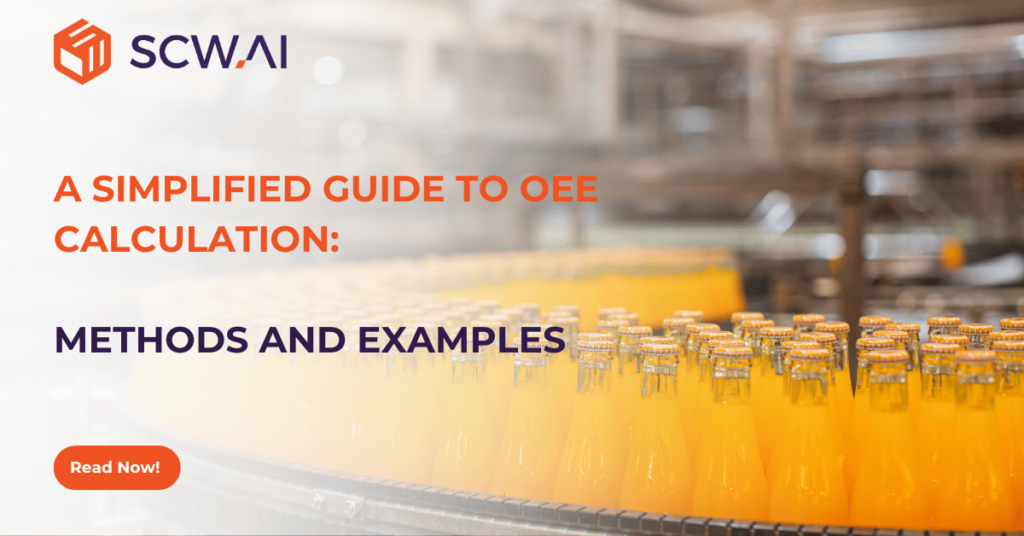Manufacturing faces a double threat: crippling maintenance costs and unplanned downtime. A McKinsey study shows heavy manufacturing sites can spend up to 40% of their operational budgets on maintenance, and ineffective maintenance leads to over 30% losses in Overall Equipment Effectiveness (OEE) due to unplanned downtime.
Total Productive Maintenance (TPM) has emerged as a powerful solution. It fosters a culture of shared responsibility for machine health across the shop floor, reducing costs and boosting OEE. But in the Industry 4.0 era, there is a higher return of TPM. Bain & Company reports manufacturers can double the positive impact of lean practices like TPM by leveraging digitalization.
This comprehensive guide equips factory managers and executives to unlock the full potential of TPM. We will explore how digitalization and AI/ML can transform TPM beyond a cultural shift, making it a data-driven powerhouse that maximizes profitability.
What is Total Productive Maintenance?

Total Productive Maintenance (TPM) is a lean manufacturing strategy that assigns responsibility for monitoring machinery and equipment health to everyone in the factory. Its primary objectives include:
- Improving Overall Equipment Effectiveness (OEE) by minimizing unplanned downtime, optimizing planned downtime, micro stops, speed losses, and scrap generation
- Reducing workplace accidents
- And minimizing the environmental impact of manufacturing.
In contemporary manufacturing, achieving these goals necessitates a cultural shift. TPM advocates for the adoption of best practices such as 5S for maintaining a clean and organized shop floor, along with digitalization to facilitate proactive maintenance and prolong equipment lifespan.
Traditionally, in many factories, only maintenance managers and technicians bear the responsibility for ensuring smooth operations. However, operators, who directly interact with the machinery, play a crucial role. Their training level enables them to perform tasks like lubrication and station cleaning, preventing micro stops and potential machine breakdowns. Additionally, their awareness of when to alert the maintenance team significantly impacts equipment longevity.
Moreover, management holds the responsibility for assessing operators’ training requirements and providing them with necessary information. They also determine key manufacturing metrics and invest in establishing a digital infrastructure for real-time shop floor monitoring to track KPIs round the clock. This way the management team can determine bottlenecks with ease and take actions to minimize them.
Digital Lean Manufacturing and TPM
Digital lean manufacturing, often referred to as Lean 2.0, involves enhancing traditional lean practices by modernizing factories through automation technologies, informative dashboards, and real-time collection of granular data. According to Bain and Company’s analysis, the digital transformation effectively doubles the impact of traditional lean methodologies.
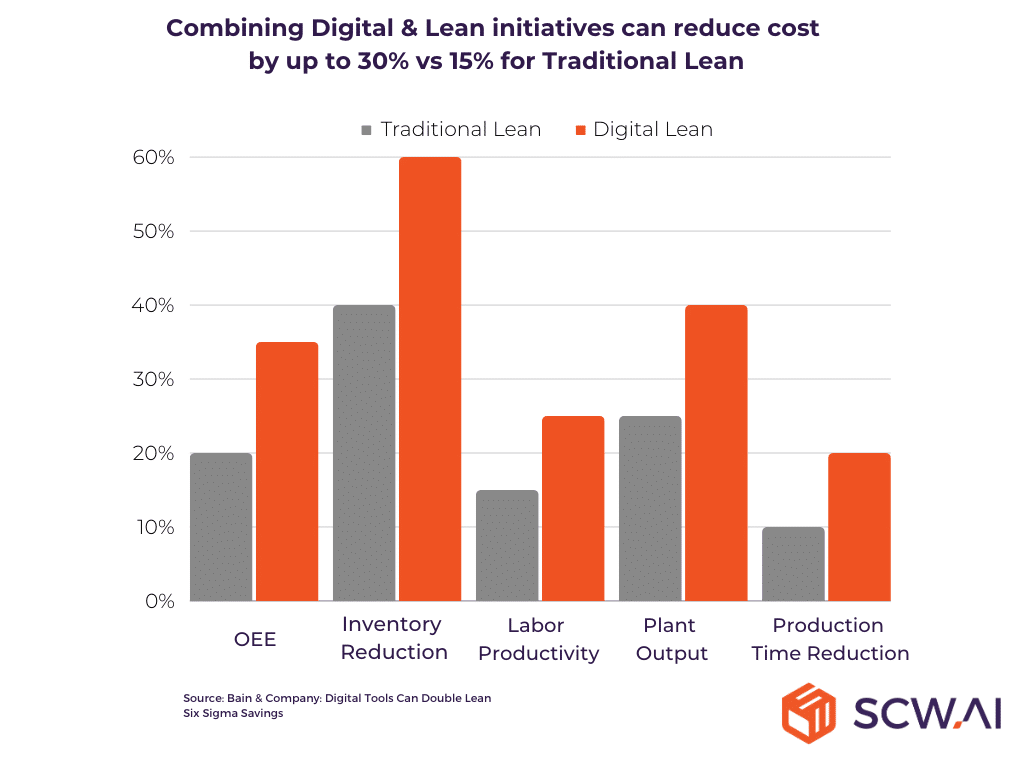
In the context of total productive maintenance and lean manufacturing, two approaches can be considered:
- Traditional Proactive Maintenance: Also known as preventive maintenance, this approach involves scheduling maintenance based on the experience and insights of the maintenance team. They establish a regular maintenance schedule, such as weekly tune-ups for machines and production lines, to prevent breakdowns. However, it’s challenging to ensure optimality with this method, as the maintenance team may inadvertently increase planned downtime to mitigate unplanned downtime.
- Digital Proactive Maintenance: In contrast, predictive maintenance, supported by machine learning models, represents a digital lean approach to proactive maintenance. Algorithms in this approach analyze various metrics, including mean time between failure, mean time to repair, correlations between electricity usage, cycle time, machine vibration, human interaction with machines, and other factors. This analysis helps determine the most optimal maintenance schedule to minimize unplanned downtime without significantly increasing planned downtime. For example, the image below depicts the machine downtime forecast accuracy of SCW.AI’s predictive maintenance model.

To find out unique use cases of AI for manufacturing sites you can read our Top 5 AI Use Cases in Manufacturing article.
Top 5 Benefits of TPM
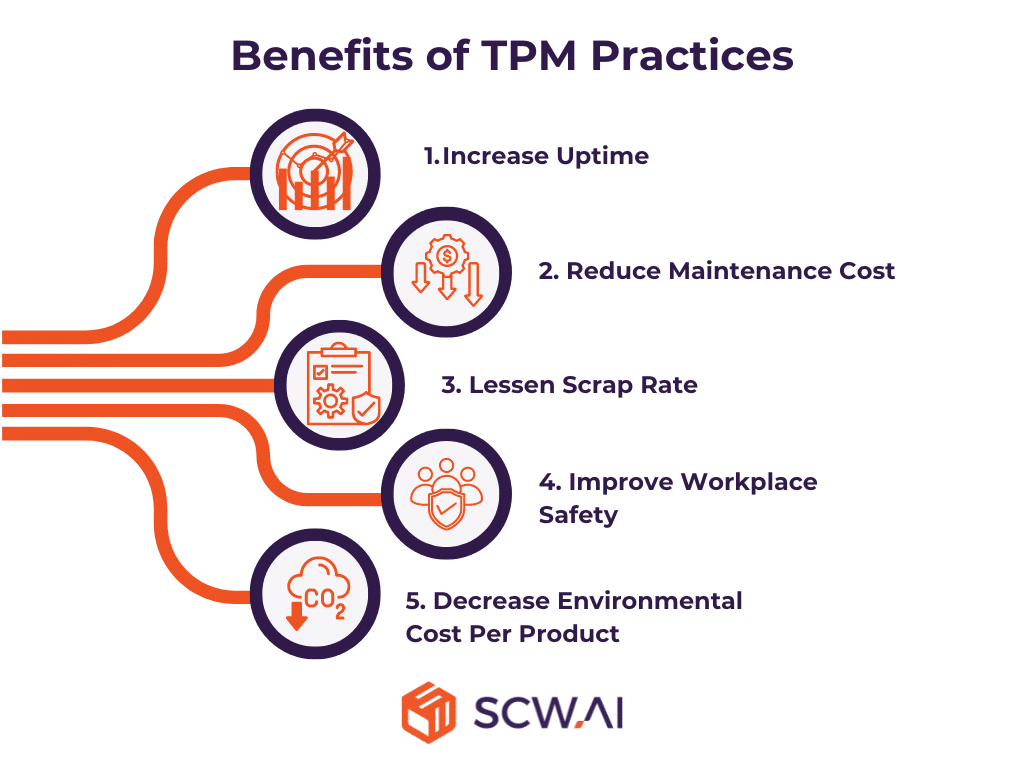
1. Increase Uptime
Planned and unplanned losses significantly reduce the line availability of factories if TPM and digital lean practices are not applied in a structured manner. For instance, according to our OEE benchmarking analysis for pharmaceutical manufacturers (See Figure Below), for a traditional pharmaceutical producer, almost 50% of OEE is lost due to a combination of unplanned and planned losses.

TPM is the lean strategy that can significantly increase line availability since unplanned downtimes are minimized by optimizing the planned maintenance percentage through predictive maintenance. Also, AI/ML models are scheduled for the least possible duration for maintenance that ensures functionality of the machines. Therefore, planned scheduled activities are also minimized.
Finally, as we delve deeper into this article later on, best practices like 5S ensure that line cleaning and machine setups are performed in standardized ways, which minimizes changeover time. Due to the positive impact of TPM and digital lean on OEE, digitized pharmaceutical manufacturers, for instance, achieve an availability of over 75%, utilizing their resources much more effectively compared to traditional pharma companies that lack TPM practices.
2. Reduce Maintenance Cost
According to Deloitte, predictive maintenance only has capability to reduce maintenance costs around 5% to 10%, and workload of the maintenance schedulers up to half which indicates up to 10% reduction in operational costs.

We believe that, especially at a time when manufacturers are struggling to find skilled laborers, automating some maintenance scheduling activities and cutting maintenance planning efforts in half can be crucial for their survival. As finding qualified engineers to perform these necessary tasks becomes increasingly difficult each day, such automation becomes imperative.
3. Lessen Scrap Rate
Here is how TPM and digitalization address reducing scrap rate challenge:
- Proactive Maintenance: By analyzing various metrics, predictive maintenance forecasts maintenance needs accurately. This reduces the chances of producing defective goods due to machine failures.
- Operator Involvement: In TPM, operators play a crucial role in equipment maintenance. Their direct interaction with machinery positions them to detect issues early on, preventing scrap generation.
- Continuous Improvement: TPM fosters a culture of continuous improvement, encouraging teams to identify and eliminate root causes of defects. By implementing tools like the 5 Whys technique, teams can delve deep into the underlying issues causing scrap and implement corrective actions effectively.
4. Improve Workplace Safety
TPM can help executives to create safer workplaces thanks to:
- Proactive Risk Mitigation: Through predictive maintenance, TPM identifies potential equipment failures before they occur, mitigating safety risks associated with sudden breakdowns.
- Operator Training and Empowerment: By providing comprehensive training and fostering a culture of safety awareness, TPM reduces the risk of accidents resulting from human error or negligence.
- Continuous Safety Improvement: TPM encourages continuous improvement in safety practices through regular audits, feedback mechanisms, and safety training programs. Thus, employees actively participate in identifying and addressing safety concerns.
5. Decrease Environmental Cost Per Product
Improved OEE resulting from increased uptime and reduced scrap time indicates that a facility can produce the same amount of product while employing the same human and capital resources, but with less waste. Consequently, there exists a negative correlation between OEE and the product carbon footprint.
Therefore, TPM can be leveraged to enhance sustainability KPIs. For example, through TPM practices, manufacturers can decrease their emission intensity, which is calculated by dividing a company’s GHG emissions by its total output.
As demonstrated by an EY study, improved corporate sustainability positively influences business performance in various ways (See Figure Below).
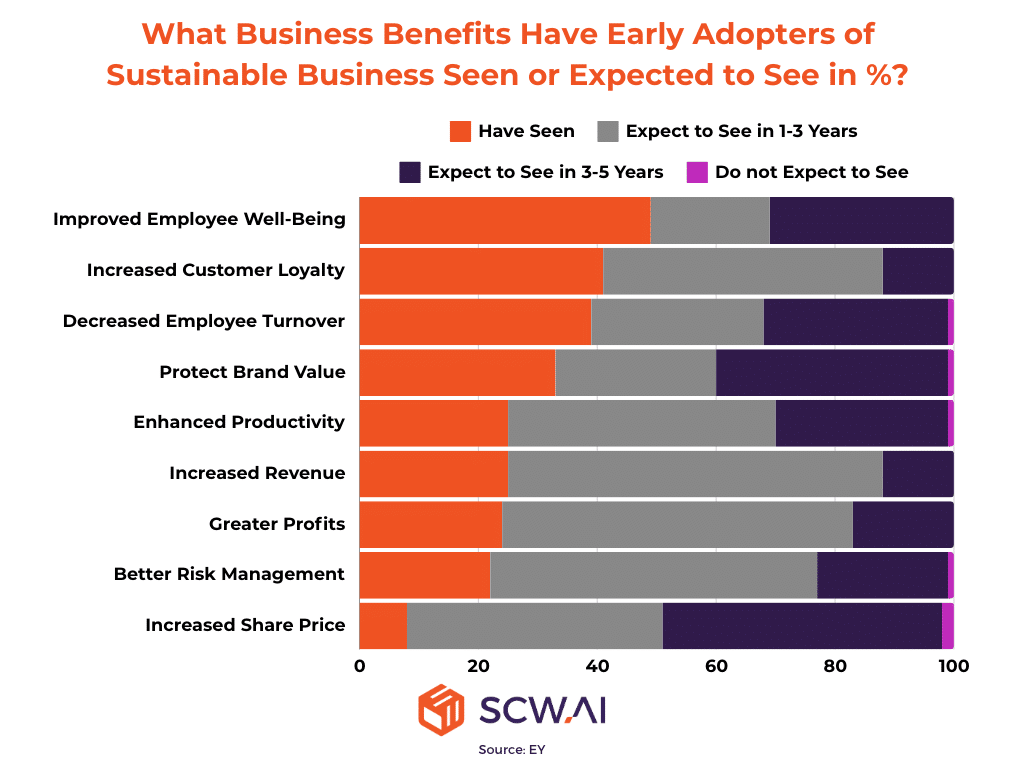
3 TPM Best Practices
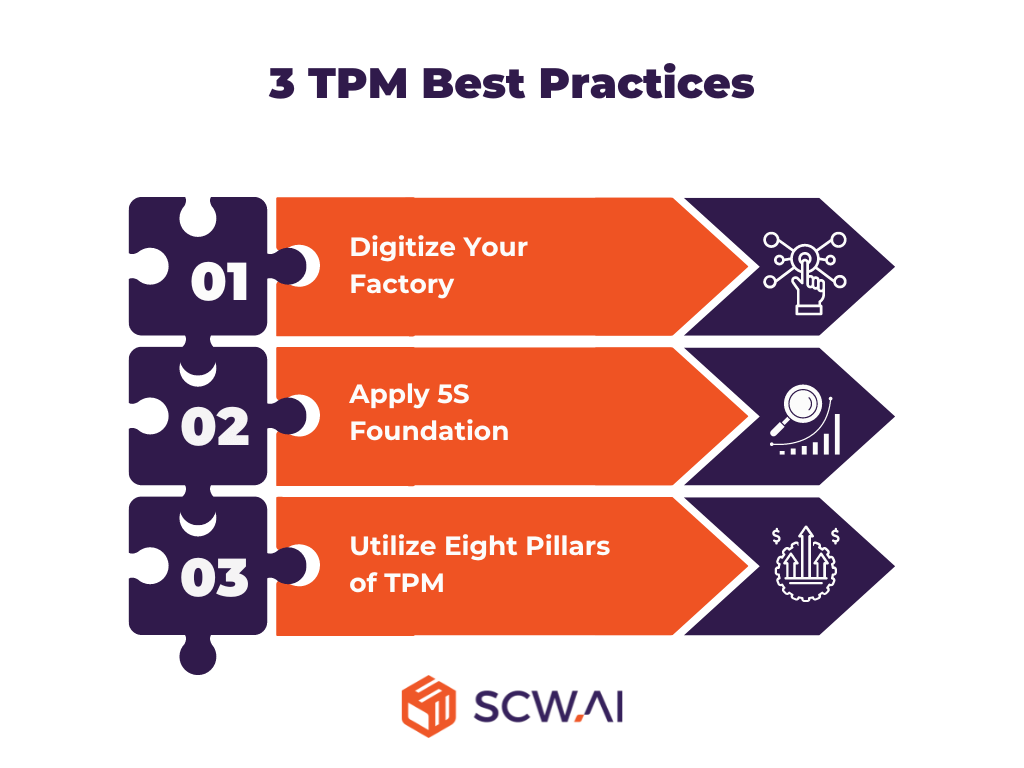
1. Digitize Your Factory
As of now, we primarily mention ML models and predictive maintenance to illustrate the relationship between digitalization and TPM. However, the connection between the two concepts runs even deeper and can be categorized under the following three pillars:
- Digital Factory for monitoring and managing activities related to TPM.
- Digitalization for the effective maintenance of machines.
- Digital technologies for the effective utilization and training of labor.
Digital Factory for Monitoring and Managing Activities Related to TPM
Without measuring KPIs, assessing and improving business performance becomes a task that relies on luck. To effectively manage and monitor processes, factories need to:
- Collect real-time data at a granular level to observe correlations between downtime and scrap production across various aspects such as lines, machines, labor, and products. Data on cycle time, machine stoppages, scrap rate, availability, labor check-ins, mean time to failure, mean time to repair, and more are valuable inputs for analysis. To ensure real-time data collection, manufacturers can utilize technologies such as OPC connections, Modbus PLC, IoT devices, and more.
- Interpret data using real-time dashboards that provide information about which machines and workers are completing tasks as planned within specific time frames. For TPM, having dashboards on metrics such as OEE and its waterfall breakdown, cycle time, maintenance metrics, setup variance for workers, and similar parameters can provide valuable insights.
For instance, the image below belongs to SCW.AI’s Maintenance Performance Report that provides input on generic maintenance metrics.
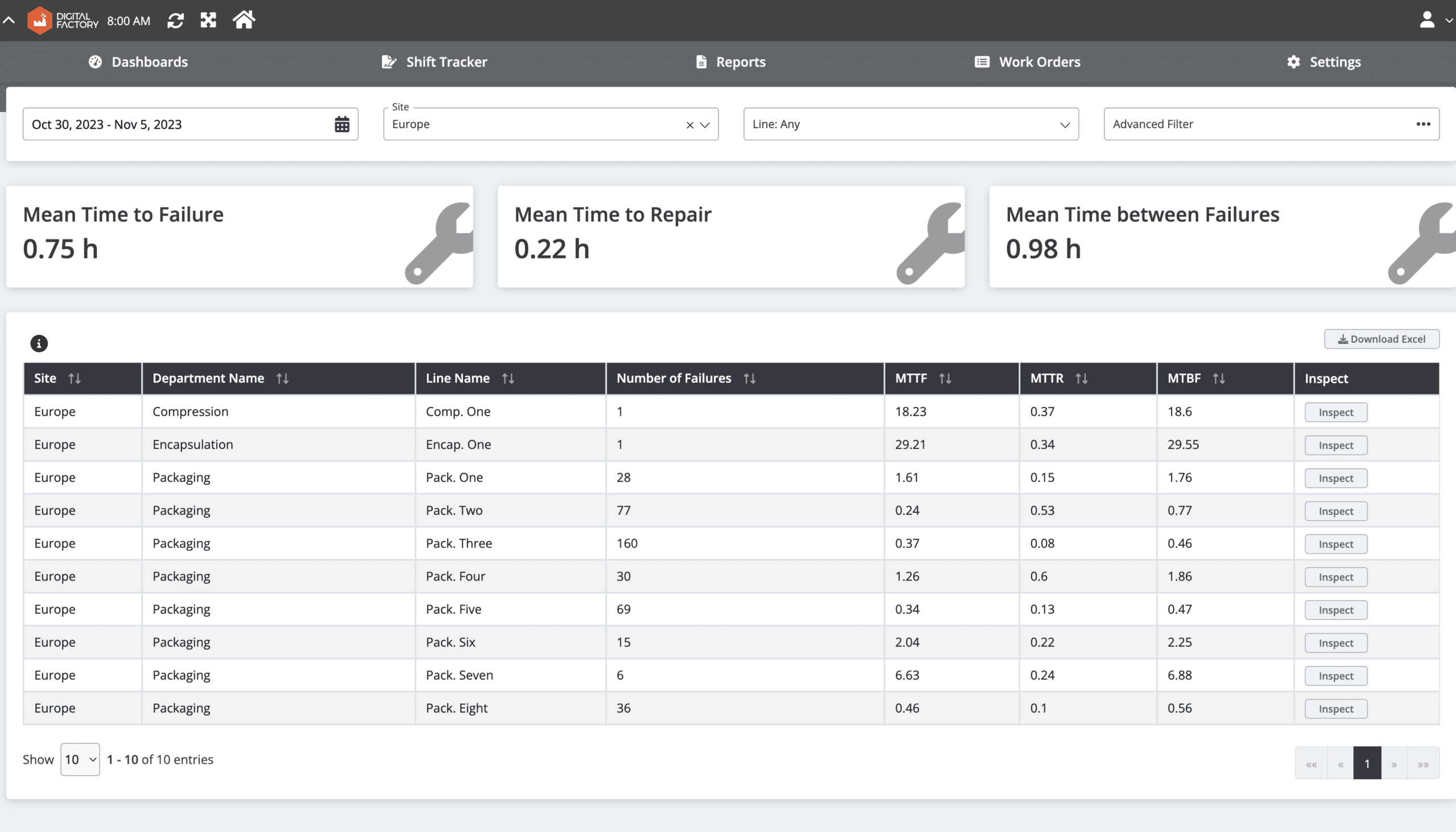
Digitalization for the Effective Maintenance of Machines
Under the digitalization pillar of TPM best practices, two applications of AI are extremely valuable for manufacturers. The first one, as previously mentioned, is machine learning-driven predictive maintenance, which can reduce maintenance costs and increase uptime by predicting machine failure before it occurs and scheduling maintenance accordingly.
Another effective technology for increasing machine runtime is the use of digital twins of factories. These digital replicas provide valuable information for maintenance and management teams. For example, as shown in the image below, digital twins can generate heat maps for visual inspections, aiding maintenance teams in making proactive maintenance decisions.

Similarly, digital twins enable realistic simulations that allow engineers to experiment with new parameter values for production without taking any risks. For instance, reducing machine speed by 5% can increase throughput within a given timeframe, since slower pace of production can significantly reduce the occurrence of machine breakdowns.
Digital Technologies for the Effective Utilization and Training of Labor
Since TPM holds everyone accountable, from the shop floor to equipment maintenance, having data on the affinity level of operators with specific machines and production processes is crucial. This allows manufacturers to schedule labor more optimally to ensure the healthy functioning of equipment.

By monitoring labor performance, managers can develop tailored training programs. Generative AI can be useful for creating videos, images, and text for training materials, enabling workers to gain the necessary knowledge to use machines effectively.
2. Apply 5S Foundation
The 5S framework—Sort, Set in Order, Shine, Standardize, and Sustain—lays the groundwork for optimizing workspace functionality and minimizing waste.
- Sort: The initial step involves streamlining workspace, removing unnecessary items that impede workflow. By eliminating non-essential tools and materials, manufacturers create a leaner environment conducive to smooth operations.
- Set in Order: This phase focuses on arranging essential items in an ergonomic and intuitive manner. This systematic organization not only reduces search times but also minimizes the risk of errors and accidents.
- Shine: It emphasizes the importance of regular maintenance and upkeep. A clean and well-maintained workspace enhances morale and extends equipment lifespan and reliability. By integrating routine cleaning and inspection tasks into daily operations, manufacturers uphold TPM principles of preventive maintenance and equipment care.
- Standardize: This phase aims to establish uniform practices and procedures across the organization. By documenting best practices and implementing standardized work instructions, manufacturers ensure that operational excellence becomes ingrained in the company culture.
- Sustain: The final “S” in the 5S framework emphasizes the need for continuous improvement and long-term sustainability. Sustaining the gains achieved through the previous steps requires ongoing vigilance and commitment from all levels of the organization. By fostering a culture of continuous improvement and providing ongoing training and support, manufacturers can ensure that the benefits of 5S permeate throughout the organization, driving efficiency and productivity in tandem with TPM initiatives.
3. Utilize Eight Pillars of TPM
The Eight Pillars of TPM encapsulate a holistic approach to maximizing equipment effectiveness and minimizing losses throughout the manufacturing process. These pillars serve as guiding principles for implementing TPM strategies effectively:
- Autonomous Maintenance: Empowering operators to take ownership of basic equipment maintenance tasks, such as cleaning, lubrication, and inspection.
- Planned Maintenance: By establishing regular maintenance schedules based on equipment condition and operational requirements, manufacturers can minimize unplanned downtime and extend equipment lifespan.
- Quality Maintenance: Integrating quality control measures into the maintenance process ensures that equipment performance aligns with product quality standards.
- Focused Improvement: Encouraging cross-functional teams to identify and address root causes of equipment inefficiencies fosters a culture of continuous improvement.
- Early Equipment Management: Involving equipment designers and engineers in the early stages of equipment procurement and design facilitates the development of reliable and maintainable systems, minimizing lifecycle costs and maximizing equipment uptime.
- Education and Training: Providing comprehensive training programs for operators and maintenance personnel ensures that all stakeholders possess the necessary skills and knowledge to perform their roles effectively.
- Administrative and Office TPM: Extending TPM principles beyond the shop floor to administrative and aligning business processes with production objectives.
- Safety, Health, and Environment: Ensures compliance with regulatory requirements and promotes a safe and sustainable work environment for all employees.
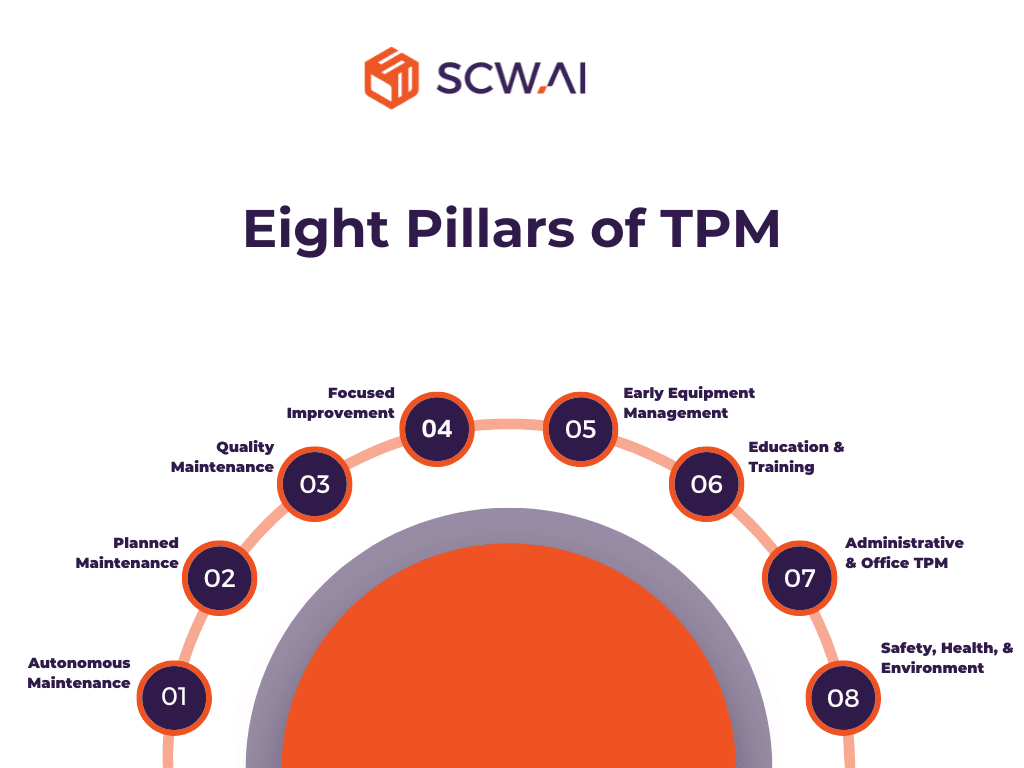
Improve Your TPM with SCW.AI
SCW.AI supports manufacturers in all lean activities, including TPM, by offering essential Industry 4.0 tools. With features like Global–Site–Line–Station Views, OEE Waterfall Analysis, Maintenance Reports, and Labor Performance Reports, you can effortlessly monitor your factory and track progress towards your goals. Additionally, we design machine learning algorithms for predictive maintenance and generative AI-driven digital twins to minimize machine downtime.
To learn more about our Digital Factory Platform, book a demo with us now.

